Active oxygen management, fire encirclement, and operational verification system
a technology of active oxygen and operational verification, applied in the direction of computer control, securing communication, program control, etc., can solve the problems of fire doors that cannot communicate with one another, fire doors that cannot close, and none of these fire doors have the intrinsic ability to close. , to achieve the effect of limiting the spread and lowering the cost of insurance premiums
- Summary
- Abstract
- Description
- Claims
- Application Information
AI Technical Summary
Benefits of technology
Problems solved by technology
Method used
Image
Examples
Embodiment Construction
[0050]FIG. 1 is an overall diagram showing multiple fire doors each having a door controller, connected to a central site and to each other via a network.
[0051] Shown is a representative building with areas A, B, C, and D. Also shown are doors 10, 10A, 10B, 10C, 10D, 10E, 10F, 10G, 10H, 10J, 10K, and 10L, vents V and V1, central controller 200 in the emergency management office.
[0052]FIG. 2 is a diagram of one side of door 10 shown in FIG. 1 (in this case a rolling overhead fire). FIG. 3 is a perspective view of the other side of the fire door 10 of FIGS. 1 and 2.
[0053]FIG. 2 illustrates the fire door 10 in an open, first position, whereas FIG. 3 illustrates the fire door 10 in a closed, second position. As shown in FIG. 3, a programmable door controller 100 is located adjacent to door 10. As described below, the programmable door controller 100 is connected to various sensors and detector associated with door 10, and is interconnected to the central controller in the central ope...
PUM
 Login to View More
Login to View More Abstract
Description
Claims
Application Information
 Login to View More
Login to View More - R&D
- Intellectual Property
- Life Sciences
- Materials
- Tech Scout
- Unparalleled Data Quality
- Higher Quality Content
- 60% Fewer Hallucinations
Browse by: Latest US Patents, China's latest patents, Technical Efficacy Thesaurus, Application Domain, Technology Topic, Popular Technical Reports.
© 2025 PatSnap. All rights reserved.Legal|Privacy policy|Modern Slavery Act Transparency Statement|Sitemap|About US| Contact US: help@patsnap.com



